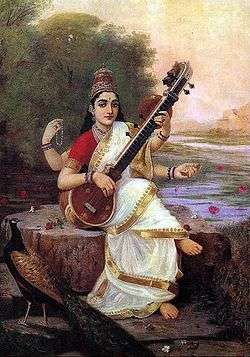Bhairav (raga)
| Raag Bhairav | |
 | |
| Thaat | Bhairav |
| Aaroha | Sa Re Ga Ma Pa Dha Ni Sa' |
| Avroha | Sa' Ni Dha Pa Ma Ga Re Sa |
| Pakad | Ga Ma Dha Dha Pa Ga Ma Re Re Sa |
| Vaadi | Dha |
| Samvaadi | Re |
| Prahar (Time) | Morning (Pratham Prahar) |
Raag Bhairav (Hindi: भैरव/भैरों) (Urdu: بیرو) (Sindhiبھےرو ) is a Hindustani Classical heptatonic (Sampurna) Raag of Bhairav Thaat. Traditionally it is a morning raga. In modern times, typically in Khyal Gayaki, it is usually performed as the beginning piece in concerts. It is the defining raga of its own Thaat.
Kalingada in Carnatic music has the same scale as the Bhairav in Hindustani music.
Theory
Writing about the musical theory of Hindustani music is fraught with complications. Firstly, there have been no set, formal methods of written notation. Secondly, Hindustani music is an aural tradition, and therefore writing is not an essential part of learning. However, Bhairav is a morning raag, commonly sung at the end of the concert. The raag is grave in mood and suggests seriousness, introversion as well as devotional attitude. By the mature deep temperament of this raag the musician expect to make the mood sombre. It shares the notes with Ahir Bhairav which has a sombre temperament.
Arohana & Avarohana
Sa, Komal Re, Ga, Ma, Pa, Komal Dha, Ni, Sa' C, D♭, E, F, G, A♭, B, C'
Sa', Ni, Komal Dha, Pa, Ma, Ga, Komal Re, Sa C', B, A♭, G, F, E, D♭, C
Pakad or Chalan
Komal Dha - Ni - Sa
Sa - Komal Re - Sa
Sa - Komal Re - Kali - Ma - Kali - Pa - Ga - Ni - Ga
Organization & Relationships
Related ragas:
Thaat: Bhairav
Behavior
Behavior refers to practical aspects of the music. It is complicated to talk about this for Hindustani music since many of the concepts are fluid, changing, or archaic. The following information cannot be accurate, but it can attempt to reflect how the music existed. The Performance for this raga is solemnly serious. The raga comes across as a musical entity with mood of meditation, philosophical depth and emotional richness.
Samay (Time)
Bhairav is an early morning raag. But it is also used as a concluding piece and as such has been performed even at night, but always in Deep or high-classical rendering. If one has to sing or play Bhairav as a main piece it has to be in the morning time.
Seasonality
Bhairav is one of few raags that can be sung in any season.
Rasa
Raag Bhairav is typically performed with a peaceful, serious, and serene mood.
Film Songs
Bhairav is a popular raga for film songs. Here are some film songs based on Bhairav:
- "Amma Roti De Baba Roti De" - Sansar, 1952
- "Hanse Tim Tim" - Sansar, 1952
- "Mohe Bhul Gaye Sanvariya" - Baiju Bawra, 1952
- "Jaago, Mohan Pyare Jaago" - Jagte Raho, 1956
- "Mana Re Hari Ke Guna" - Musafir, 1957
Historical
Bhairav is considered to be the most ancient fundamental Raag of Hindustani Classical Music. Also, it is believed that Bhairav was the very first Raag to be created by Lord Shiva. This raga is being used in worship by Hindus in their religious imagination of "Lord Shiva & Parvati".
References
External links
- https://www.swarganga.org/raaga_details.php?raagid=23
- http://www.shadjamadhyam.com/index.php?q=bhairav_derivatives
